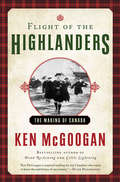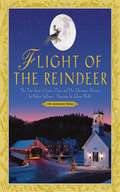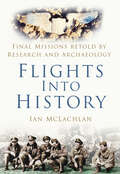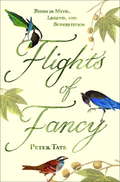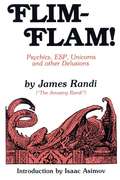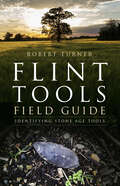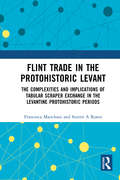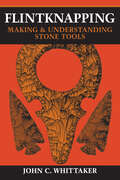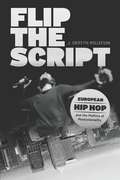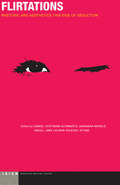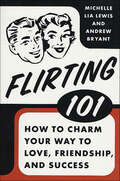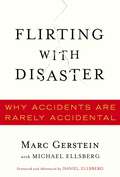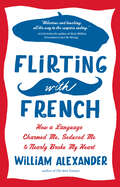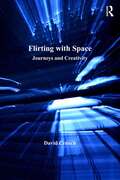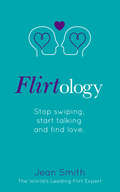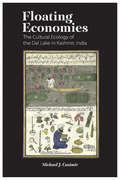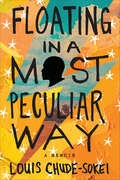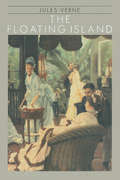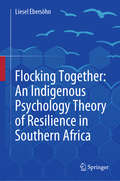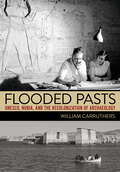- Table View
- List View
Flight of the Highlanders: The Making of Canada
by Ken McGooganBestselling author Ken McGoogan tells the story of those courageous Scots who, ruthlessly evicted from their ancestral homelands, were sent to Canada in coffin ships, where they would battle hardship, hunger and even murderous persecution.After the Scottish Highlanders were decimated at the 1746 Battle of Culloden, the British government banned kilts and bagpipes and set out to destroy a clan system that for centuries had sustained a culture, a language and a unique way of life. The Clearances, or forcible evictions, began when landlords—among them traitorous clan chieftains—realized they could increase their incomes dramatically by driving out tenant farmers and dedicating their estates to sheep.Flight of the Highlanders: The Making of Canada intertwines two main narratives. The first is that of the Clearances themselves, during which some 200,000 Highlanders were driven—some of them burned out, others beaten unconscious—from lands occupied by their forefathers for hundreds of years. The second narrative focuses on resettlement. The refugees, frequently misled by false promises, battled impossible conditions wherever they arrived, from the forests of Nova Scotia to the winter barrens of northern Manitoba.Between the 1770s and the 1880s, tens of thousands of dispossessed and destitute Highlanders crossed the Atlantic —prototypes for the refugees we see arriving today from around the world. If today Canada is more welcoming to newcomers than most countries, it is at least partly because of the lingering influence of those unbreakable refugees. Together with their better-off brethren—the lawyers, educators, politicians and businessmen—those indomitable Highlanders were the making of Canada.
Flight of the Reindeer: The True Story of Santa Claus and His Christmas Mission
by Robert Sullivan Glenn WolffChildren have believed the legend forever: On one evening each year a jolly old elf and eight reindeer fly all night long to deliver gifts around the world. The fact is, solid evidence abounds. Robert Sullivan, a senior editor at Life magazine, diligently gathered documentation from scientists, historians, zoologists, and Arctic explorers to prove that Santa is not just a myth. First, the reindeer: Do they really fly? "We used to think it was just extended leaping," says Tony Vecchio, director of the Roger Williams Park Zoo in Providence, Rhode Island. "But recent evidence has confirmed that it is true flight." And Santa Claus? "He's just as real as the gifts he brings," reports Will Steger, the famed Arctic explorer. The gorgeous illustrations, convincing photos, and charming text make this book a special holiday gift.
Flights Into History: Final Missions Retold by Research and Archaeology
by Ian McLachlanIn this compelling sequel to Final Flights, aviation archaeologist Ian McLachlan has reconstructed the dramatic last flights of Second World War airmen, including the first Fortress to fall in combat from the USAAF's 447th Bomber Group; the final flight of an intruder Mosquito pursuing a German night fighter; the courage of a Lancaster pilot responsible for six lives aboard a burning aircraft; the story of a Spitfire's last flight and its heroic Belgian pilot. Exciting stories are also recounted of those whose misdirected courage saw them serve under the swastika. In reconstructing long-forgotten wartime events, often from buried wreckage, eyewitness accounts and contemporary documentation, aviation archaeologists can bring recognition to the individual flyers involved and shed new light on the air war over Britain and Europe during the Second World War. Even the discovery of small fragments can be significant. They provide evidence or prompt new research, revealing stories that offer a uniquely human dimension and reveal the hopes, fears, aspirations and pleasures of the aircrew involved. Ian McLachlan and other aviation archaeologists have now done them justice.
Flights from Fassberg: How a German Town Built for War Became a Beacon of Peace (Willie Morris Books in Memoir and Biography)
by Colonel Wolfgang W. SamuelWolfgang W. E. Samuel, Colonel, US Air Force (Ret.), interweaves his story and that of his family with the larger history of World War II and the postwar world through a moving recollection and exploration of Fassberg, a small town in Germany few have heard of and fewer remember. Created in 1933 by the Hitler regime to train German aircrews, Fassberg hosted Samuel’s father in 1944–45 as an officer in the German air force. As fate and Germany's collapse chased young Wolfgang, Fassberg later became his home as a postwar refugee, frightened, traumatized, hungry, and cold.Built for war, Fassberg made its next mark as a harbinger of the new Cold War, serving as one of the operating bases for Allied aircraft during the Berlin Airlift in 1948. With the end of the Berlin Crisis, the airbase and town faced a dire future. When the Royal Air Force declared the airbase surplus to its needs, it also signed the place's death warrant, yet increasing Cold War tensions salvaged both base and town. Fassberg transformed again, this time into a forward operating base for NATO aircraft, including a fighter flown by Samuel's son.Both personal revelation and world history, replete with tales from pilots, mechanics, and all those whose lives intersected there, Flights from Fassberg provides context to the Berlin Airlift and its strategic impact, the development of NATO, and the establishment of the West German nation. The little town built for war survived to serve as a refuge for a lasting peace.
Flights of Fancy: Birds in Myth and Legend
by Peter TateThe perfect bedside companion for every bird-watcher and nature lover, inside Flights of Fancy you'll find: Cranes--"Don't promise the crane in the sky, but give the titmouse in your hand." Russian proverb. Magpies--"One for sorrow, two for joy..." Traditional English rhyme. Owls--"The owl shrieked at thy birth, an evil sign." Shakespeare, Henry VI, Part III. Peacocks--"The peacock is ashamed of its large black feet." Medieval Persian tradition. Ravens--"When the raven tried to bring fire to the world, ash turned its feathers black." Cherokee Indian legend. Swans--"Sewing a swan's feather into your husband's pillow will keep him faithful." British superstition, and much more.
Flim-flam!: Psychics, ESP, Unicorns And Other Delusions
by Isaac Asimov James RandiJames Randi is internationally known as a magician and escape artist. But for the past thirty-five years of his professional life, he has also been active as an investigator of the paranormal, occult, and supernatural claims that have impressed the thinking of the public for a generation: ESP, psychokinesis, psychic detectives, levitation, psychic surgery, UFOs, dowsing, astrology, and many others. Those of us unable to discriminate between genuine scientific research and the pseudoscientific nonsense that has resulted in fantastic theories and fancies have long needed James Randi and Flim-Flam! <P><P> In this book, Randi explores and exposes what he believes to be the outrageous deception that has been promoted widely in the media. Unafraid to call researchers to account for their failures and impostures, Randi tells us that we have been badly served by scientists who have failed to follow the procedures required by their training and traditions. Here he shows us how what he views as sloppy research has been followed by rationalizations of evident failures, and we see these errors and misrepresentations clearly pointed out. Mr. Randi provides us with a compelling and convincing document that will certainly startle and enlighten all who read it.
Flint Fights Back: Environmental Justice and Democracy in the Flint Water Crisis (Urban and Industrial Environments)
by Benjamin J. PauliAn account of the Flint water crisis shows that Flint's struggle for safe and affordable water is part of a broader struggle for democracy.When Flint, Michigan, changed its source of municipal water from Lake Huron to the Flint River, Flint residents were repeatedly assured that the water was of the highest quality. At the switchover ceremony, the mayor and other officials performed a celebratory toast, declaring “Here's to Flint!” and downing glasses of freshly treated water. But as we now know, the water coming out of residents' taps harbored a variety of contaminants, including high levels of lead. In Flint Fights Back, Benjamin Pauli examines the water crisis and the political activism that it inspired, arguing that Flint's struggle for safe and affordable water was part of a broader struggle for democracy. Pauli connects Flint's water activism with the ongoing movement protesting the state of Michigan's policy of replacing elected officials in financially troubled cities like Flint and Detroit with appointed “emergency managers.”Pauli distinguishes the political narrative of the water crisis from the historical and technical narratives, showing that Flint activists' emphasis on democracy helped them to overcome some of the limitations of standard environmental justice frameworks. He discusses the pro-democracy (anti–emergency manager) movement and traces the rise of the “water warriors”; describes the uncompromising activist culture that developed out of the experience of being dismissed and disparaged by officials; and examines the interplay of activism and scientific expertise. Finally, he explores efforts by activists to expand the struggle for water justice and to organize newly mobilized residents into a movement for a radically democratic Flint.
Flint Tools Field Guide: Identifying Stone Age Tools
by Robert TurnerOur prehistoric ancestors used flint tools every day; they were of vital importance for cutting and scraping, used for hunting, preparing food, making clothing and building shelters, and their remnants are scattered around the countryside.Unearthing such a find is a magical moment – a direct link to events thousands of years before – but how do you identify the piece of flint you find out in the field? Is it only a lump of flint, or did it really have an important function as a tool prized by our ancestors? And how old is it, exactly?In Flint Tools Field Guide, archaeologist and flint knapper Robert Turner opens a window into prehistoric archaeology, using hand-drawn illustrations and photographs to explain how to identify tools and their uses, as well as approximate their age. This is an important insight into how people lived and worked so many years ago.
Flint Trade in the Protohistoric Levant: The Complexities and Implications of Tabular Scraper Exchange in the Levantine Protohistoric Periods
by Francesca Manclossi Steven A RosenFlint Trade in the Protohistoric Levant offers an in-depth case study of the production and exchange of tabular scrapers. Crossing cultural and ecological boundaries and traded from the desert to the settled zone, these tools encompassed both ritual and quotidian functions over the course of well over the two millennia of the existence of the exchange system. Analyses focus on the changing nature of the production systems, dynamics of value in changing contexts of production and use, ritual contexts and meaning. Extending throughout the Levant, the tabular scraper complex is compared and contrasted to other contemporary production and exchange systems (ceramics, chipped stone, ground stone, copper, beads), offering a rich picture of the complexities of late prehistoric trade, transcending linear evolutionary frameworks, and simple models. Adopting a chaîne opératoire approach to the use-life of the artifacts, the artifacts can be seen to transform over time and place, made, used, recycled, and ultimately discarded, each stage in its own cultural contexts. The rise and decline of this exchange complex reflects both the geo-political history of the region and the general role of lithic industries in these societies. Focusing on late prehistoric times in the Near East, the discussions will of relevance to all researchers interested in the role of exchange in the evolution of complex economies. It offers an analysis of exchange systems based on a matrix of factors which should be of interest to all researchers interested in the evolution of trade.
Flintknapping: Making & Understanding Stone Tools
by John C. WhittakerA detailed, practical guide to the ancient craft of making stone tools, featuring an archaeological analysis.Flintknapping is an ancient craft enjoying a resurgence of interest among both amateur and professional students of prehistoric cultures. In this guide, John C. Whittaker offers the most detailed handbook on flintknapping currently available and the only one written from the archaeological perspective of interpreting stone tools as well as making them.Flintknapping contains detailed, practical information on making stone tools. Whittaker starts at the beginner level and progresses to discussion of a wide range of techniques. He includes information on necessary tools and materials, as well as step-by-step instructions for making several basic stone tool types. Numerous diagrams allow the reader to visualize the flintknapping process, and drawings of many stone tools illustrate the discussions and serve as models for beginning knappers.Written for a wide amateur and professional audience, Flintknapping will be essential for practicing knappers as well as for teachers of the history of technology, experimental archaeology, and stone tool analysis.“A mid-range user’s guide to flintknapping is long overdue. There have been some admirable attempts to produce such a volume, but these have been targeted at specific, fairly narrow audiences. Not so with Flintknapping. . . . [Whittaker’s] clear aim is to reach professional archaeologists as well as hobbyists. I believe he achieves this goal with incredible skill and humor. . . . I highly recommend this book to everyone interested in flintknapping.” —Plains Anthropologist“Very attractive to readers interested in ancient crafts, survival skills, or the history of technology . . . . Far superior to anything currently available.” —James C. Woods, director, The Herrett Museum, College of Southern Idaho
Flintknapping: Making & Understanding Stone Tools
by John C. WhittakerFlintknapping is an ancient craft enjoying a resurgence of interest among both amateur and professional students of prehistoric cultures. In this new guide, John C. Whittaker offers the most detailed handbook on flintknapping currently available and the only one written from the archaeological perspective of interpreting stone tools as well as making them. Flintknapping contains detailed, practical information on making stone tools. Whittaker starts at the beginner level and progresses to discussion of a wide range of techniques. He includes information on necessary tools and materials, as well as step-by-step instructions for making several basic stone tool types. Numerous diagrams allow the reader to visualize the flintknapping process, and drawings of many stone tools illustrate the discussions and serve as models for beginning knappers. Written for a wide amateur and professional audience, Flintknapping will be essential for practicing knappers as well as for teachers of the history of technology, experimental archaeology, and stone tool analysis.
Flip the Script: European Hip Hop and the Politics of Postcoloniality
by J. Griffith RollefsonHip hop has long been a vehicle for protest in the United States, used by its primarily African American creators to address issues of prejudice, repression, and exclusion. But the music is now a worldwide phenomenon, and outside the United States it has been taken up by those facing similar struggles. Flip the Script offers a close look at the role of hip hop in Europe, where it has become a politically powerful and commercially successful form of expression for the children and grandchildren of immigrants from former colonies. Through analysis of recorded music and other media, as well as interviews and fieldwork with hip hop communities, J. Griffith Rollefson shows how this music created by black Americans is deployed by Senegalese Parisians, Turkish Berliners, and South Asian Londoners to both differentiate themselves from and relate themselves to the dominant culture. By listening closely to the ways these postcolonial citizens in Europe express their solidarity with African Americans through music, Rollefson shows, we can literally hear the hybrid realities of a global double consciousness.
Flirtations: Rhetoric and Aesthetics This Side of Seduction (Idiom: Inventing Writing Theory)
by Barbara Natalie Nagel Lauren Shizuko StoneWhat is flirtation, and how does it differ from seduction?In historical terms, the particular question of flirtation has tended to be obscured by that of seduction, which has understandably been a major preoccupation for twentieth-century thought and critical theory. Both the discourse and the critique of seduction are unified by their shared obsession with a very determinate end: power. In contrast, flirtation is the game in which no one seems to gain the upper hand and no one seems to surrender. The counter-concept of flirtation has thus stood quietly to the side, never quite achieving the same prominence as that of seduction. It is this elusive (and largely ignored) territory of playing for play’s sake that is the subject of this anthology.The essays in this volume address the under-theorized terrain of flirtation not as a subgenre of seduction but rather as a phenomenon in its own right. Drawing on the interdisciplinary history of scholarship on flirtation even as it re-approaches the question from a distinctly aesthetic and literary-theoretical point of view, the contributors to Flirtations thus give an account of the practice of flirtation and of the figure of the flirt, taking up the act’s relationship to issues of mimesis, poetic ambiguity, and aesthetic pleasure. The art of this poetic playfulness—often read or misread as flirtation’s “empty gesture”—becomes suddenly legible as the wielding of a particular and subtle form of nonteleological power.
Flirting 101: How to Charm Your Way to Love, Friendship, and Success
by Michelle Lia Lewis Andrew BryantEvery party has a stand-out - a guy or gal who breezes into a room and instantly attracts everyone's attention. It's not always about looks or money, so what's their secret? It's all about flirting! A good flirt knows how to make anyone around them feel good, and that's a very powerful skill. Luckily, it is a skill that can be learned. FLIRTING 101 will show you how to:-Discover your inner flirt -Increase your self-confidence -Take advantage of non-verbal communication-Overcome your fear of rejectionAnd much more!Whether you want to attract a life partner, improve business, or just have a little fun, this book is packed with useful tips, stories, practical exercises, and quizzes to help you transform into the most fabulous flirt you can be.
Flirting in the Era of #MeToo: Negotiating Intimacy
by Rob Cover Kyra Clarke Alison BartlettThis book provides a contemporary review of the social practices and representations of flirting. In the wake of #MeToo, flirting has become entangled with stories of harassment and abuse that have generated both outrage and confusion. Nevertheless, this book argues that negotiating intimacy has always been an ambiguous social practice that can be risky and fraught, and examines how the presiding perception of flirting is constructed in contemporary cultural media. The book interrogates the relation between flirting and scandal, the kinds of scripts available in popular culture, and relations to feminism and other current social theories around gender and sexuality. It asks the questions; how can desire be declared? How can playfulness be understood? And what kind of language is available to speak about these complexities? Drawing from a range of media forms such as public scandal, reality television, and teen film, Flirting in the Era of #MeToo argues that contemporary flirting is both provocative and conservative in its negotiation of an assemblage of shifting values, and considers possibilities for social innovation and change in light of these competing tensions.
Flirting with Disaster: Why Accidents Are Rarely Accidental
by Michael Ellsberg Marc S. GersteinWe tend to think of disasters as uncontrollable acts of nature or inevitable accidents. But are such incidents unavoidable or ever truly accidental? The authors of this remarkable book say we actually do have the power to prevent tragedies such as the flooding from Hurricane Katrina, the death toll from dangerous medicines like Vioxx, and the explosion of the Space Shuttle Columbia. Marc Gerstein and Michael Ellsberg insist that disasters need not be inevitable if we learn from history, prepare carefully for the worst case, and speak out when we see danger looming. This revelation makes their compelling study extremely valuable for readers in business, government, medicine, academia—indeed all walks of life. Flirting with Disaster will do for catastrophe what Blink did for intuition, and The Black Swan did for probability: provide a popular audience with an engaging, in-depth view of a complex and important topic. Gerstein and Ellsberg examine the culture of institutions: why even people of good will and inside knowledge underestimate risk; feel psychologically incapable of averting tragedy and unable to pick up the pieces afterward; and don’t come forward forcefully enough to head off catastrophe. They also celebrate those who go beyond the call of duty to save others, including Dr. David Graham of the FDA who courageously stood up to reveal Vioxx’s deadly effects. One such whistleblower contributes both a foreword and an afterword: Daniel Ellsberg, renowned for releasing the Pentagon Papers. Flirting with Disaster provides a pathway for those who want to foster truthtelling in their organization and head off disasters in the making. At once alarming, entertaining, and hopeful, it offers readers very real and practical lessons for everyday life.
Flirting with French: How a Language Charmed Me, Seduced Me, and Nearly Broke My Heart
by William Alexander“A delightful and courageous tale and a romping good read. Voila!” —Mark Greenside, author of I’ll Never Be French (No Matter What I Do) William Alexander is more than a Francophile. He wants to be French. There’s one small obstacle though: he doesn’t speak la langue française. In Flirting with French, Alexander sets out to conquer the language he loves. But will it love him back? Alexander eats, breathes, and sleeps French (even conjugating in his dreams). He travels to France, where mistranslations send him bicycling off in all sorts of wrong directions, and he nearly drowns in an immersion class in Provence, where, faced with the riddle of masculine breasts, feminine beards, and a turkey cutlet of uncertain gender, he starts to wonder whether he should’ve taken up golf instead of French. While playing hooky from grammar lessons and memory techniques, Alexander reports on the riotous workings of the Académie française, the four-hundred-year-old institution charged with keeping the language pure; explores the science of human communication, learning why it’s harder for fifty-year-olds to learn a second language than it is for five-year-olds; and, frustrated with his progress, explores an IBM research lab, where he trades barbs with a futuristic hand-held translator. Does he succeed in becoming fluent? Readers will be as surprised as Alexander is to discover that, in a fascinating twist, studying French may have had a far greater impact on his life than actually learning to speak it ever would. “A blend of passion and neuroscience, this literary love affair offers surprise insights into the human brain and the benefits of learning a second language. Reading William Alexander’s book is akin to having an MRI of the soul.” —Laura Shaine Cunningham, author of Sleeping Arrangements “Alexander proves that learning a new language is an adventure of its own--with all the unexpected obstacles, surprising breakthroughs and moments of sublime pleasure traveling brings.” —Julie Barlow, author of Sixty Million Frenchmen Can’t Be Wrong
Flirting with Space: Journeys and Creativity
by David CrouchThe idea of 'flirting' with space is central to this book. Space is conceptualised as being in constant flux as we make our way through various contexts in our daily lives, and is considered in relation to encounters with complexities and flows of material culture. This book focuses on journeys, which are perceived as dynamic processes of contemporary life and its spaces, and how creativity happens in the inter-relations of space and journeys encourage creativity. Unravelled through a range of empirical case studies of journeys through and encountered with space, this book builds new critical syntheses of the intertwining of space and life. Based on investigations undertaken by the author over the past 20 years, it explores the mundane and the exotic, the 'lay' and the 'artistic', combining and inter-relating them in a diversity of time and expression, fleeting and surviving. Such investigations, using both visual and non-visual material, include examinations of allotment holding, the work of artists, caravanning and tourism, photography and parish maps. The analyses of such seemingly disparate subjects are linked together and build on each other to create a fascinating and original view of humanity's interaction with space. Included are fresh discussions of belonging, disorientation and the working of identity and play. The notion of 'gentle politics' is introduced.
Flirtology
by Jean Smith. How can I tell when someone is flirting with me?. How can I be a more confident flirt?. How do I avoid rejection?. Where are all the good men and women hiding?Flirtology is THE dating guide for the 21st century. In an age of swiping left and right, and hiding behind online profiles, this book shows you how to replace connectivity with connection.Flirtology debunks the myths that surround flirting in order to help you find love. It helps you to analyse what you are looking for in a potential partner, shows you how to practise your interaction skills and how to unlock your inner flirt. It will give you the confidence to speak to anyone, anywhere and get results - without every compromising who you are. It's not about games, rules and tricks - it's about presenting your real self so that you will attract the right people for you.Jean Smith is a social and cultural anthropologist who specialises in the science of flirting. For over a decade she has been helping countless clients build their confidence and find love. Her Fearless Flirting tours and Guardian Masterclasses are hugely popular and regularly sell out. In Flirtology she brings you a fun, efficient and scientifically researched guide to finding your own perfect match.
Floating Economies: The Cultural Ecology of the Dal Lake in Kashmir, India
by Michael J. CasimirIn the Himalayas of the Indian part of Kashmir three communities depend on the ecology of the Dal lake: market gardeners, houseboat owners and fishers. Floating Economies describes for the first time the complex intermeshing economy, social structure and ecology of the area against the background of history and the present volatile socio-political situation. Using a holistic and multidisciplinary approach, the author deals with the socioeconomic strategies of the communities whose livelihoods are embedded here and analyses the ecological condition of the Dal, and the reasons for its progressive degradation.
Floating In A Most Peculiar Way: A Memoir
by Louis Chude-SokeiThe astonishing journey of a bright, utterly displaced boy, from the short-lived African nation of Biafra, to Jamaica, to the harshest streets of Los Angeles—a searing memoir that adds fascinating depth to the coming-to-America storyThe first time Chude-Sokei realizes that he is &“first son of the first son&” of a renowned leader of the bygone African nation is in Uncle Daddy and Big Auntie&’s strict religious household in Jamaica, where he lives with other abandoned children. A visiting African has just fallen to his knees to shake him by the shoulders: &“Is this the boy? Is this him?&”Chude-Sokei&’s immersion in the politics of race and belonging across the landscape of the African diaspora takes a turn when his traumatized mother, who has her own extraordinary history as the onetime &“Jackie O of Biafra,&” finally sends for him to come live with her. In Inglewood, Los Angeles, on the eve of gangsta rap and the LA riots, it&’s as if he&’s fallen to Earth. In this world, anything alien—definitely Chude-Sokei&’s secret obsession with science fiction and David Bowie—is a danger, and his yearning to become a Black American gets deeply, sometimes absurdly, complicated. Ultimately, it is a boisterous pan-African family of honorary aunts, uncles, and cousins that becomes his secret society, teaching him the redemptive skill of navigating not just Blackness, but Blacknesses, in his America.
Floating Island: The Pearl Of The Pacific
by Jules VerneFirst published in 1990. Although one of Jules Verne's lesser known novels, as part of his 'Extraordinary Voyages' collection, there is still much to enjoy about 'The Floating Island'*. Written in 1895 towards the end of his career this is an adventure novel with elements of sci-fi. A French string quartet traveling from San Francisco to their next engagement in San Diego, is diverted to Standard Island. Standard Island is an immense man-made island designed to travel the waters of the Pacific Ocean. The wealth of residents of the island can only be measured in millions. The quartet is hired to play a number of concerts for the residents during their tour of the islands (Sandwich, Cook, Society, etc.) of the South Pacific. The island seems an idyllic paradise; however, it is an island divided in two. The left half's population is led by Jem Tankerdon and is known as the Larboardites. The right half's population is led by Nat Coverley and is known as the Starboardites. Despite the obstacles encountered on their journey, the two parties have a disagreement that threatens the future of the island itself.
Floating Skeletons: A Small Town Is Awash in Bones (XBooks: Forensics)
by Danielle DenegaWho will put the dead back to rest?It's the Great Flood of 1993, and much of the Midwestern U.S. is covered with water. But tiny Hardin, Missouri, is covered with something much, much worse: dead bodies.High-interest topics, real stories, engaging design, and astonishing photos are the building blocks of the XBooks, a new series of books designed to engage and motivate reluctant and enthusiastic readers alike. How can DNA help a convicted person prove their innocence? How did a burglar steal from a store without leaving any fingerprints? Why was the tiny town in Hardin, Missouri, awash with skeletons after a huge flood? With topics based in science, these action-packed books will help students unlock the power and pleasure of reading... and always ask for more!
Flocking Together: An Indigenous Psychology Theory of Resilience in Southern Africa
by Liesel EbersöhnThis book describes how those individuals who are often most marginalised in postcolonial societies draw on age-old, non-western knowledge systems to adapt to the hardships characteristic of unequal societies in transformation. It highlights robust indigenous pathways and resilience responses used by elders and young people in urban and rural settings in challenging Southern African settings (South Africa, Namibia, Lesotho and Swaziland) to explain an Indigenous Psychology theory. Flocking (rather than fighting, fleeing, freezing or fainting) is explained as a default collectivist, collaborative and pragmatic social innovation to provide communal care and support when resources are constrained, and needs are par for the course. Flocking is used to address, amongst others, climate change (drought and energy use in particular), lack of household income and securing livelihoods, food and nutrition, chronic disease (specifically HIV / AIDS and tuberculosis), barriers to access services (education, healthcare, social welfare support), as well as leisure and wellbeing. The book further deliberates whether the continued use of such an entrenched socio-cultural response mollifies citizens and decision-makers into accepting inequality, or whether it could also be used to spark citizen agency and disrupt longstanding structural disparities.
Flooded Pasts: UNESCO, Nubia, and the Recolonization of Archaeology
by William CarruthersFlooded Pasts examines a world famous yet critically underexamined event—UNESCO's International Campaign to Save the Monuments of Nubia (1960–80)—to show how the project, its genealogy, and its aftermath not only propelled archaeology into the postwar world but also helped to "recolonize" it. In this book, William Carruthers asks how postwar decolonization took shape and what role a colonial discipline like archaeology—forged in the crucible of imperialism—played as the "new nations" asserted themselves in the face of the global Cold War.As the Aswan High Dam became the centerpiece of Gamal Abdel Nasser's Egyptian revolution, the Nubian campaign sought to salvage and preserve ancient temples and archaeological sites from the new barrage's floodwaters. Conducted in the neighboring regions of Egyptian and Sudanese Nubia, the project built on years of Nubian archaeological work conducted under British occupation and influence. During that process, the campaign drew on the scientific racism that guided those earlier surveys, helping to consign Nubians themselves to state-led resettlement and modernization programs, even as UNESCO created a picturesque archaeological landscape fit for global media and tourist consumption. Flooded Pasts describes how colonial archaeological and anthropological practices—and particularly their archival and documentary manifestations—created an ancient Nubia severed from the region's population. As a result, the Nubian campaign not only became fundamental to the creation of UNESCO's 1972 World Heritage Convention but also exposed questions about the goals of archaeology and heritage and whether the colonial origins of these fields will ever be overcome.
